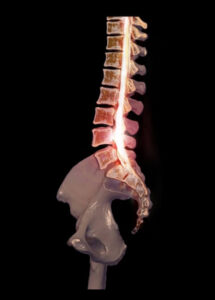Blog, Physiotherapy
Lower Back Scan Results: What They Really Mean for Your Pain

One of the most frequent questions we get asked at M Physio is: “Do I have a disc bulge? Should I get a scan to check?”
Lower back pain is incredibly common — in fact, up to 80% of people will experience it at some point in their lives.
With so many people turning to MRIs and CT scans for answers, it’s easy to assume that what’s seen on a lower back scan perfectly explains why you’re in pain.
But the reality is a little more complicated. Understanding what a disc bulge really is, what a lower back scan shows (and doesn’t show), and how physiotherapy can help will give you clarity and confidence to move forward with your recovery.
In this article we will explore the 3 key facts for disc bulges in the lower back:
- What Is a Disc Bulge and How Does It Happen?
- What A Lower Back Scan Shows… and Why It Might Not Match Your Pain
- How Physiotherapy Helps You Recover and Prevent Re-Injury
What Is a Disc Bulge and How Does It Happen?
Between the bones (vertebrae) of your spine are spinal discs — think of them as small cushions that help absorb shock and allow your spine to move smoothly. A disc bulge happens when the soft inner part of the disc starts to push outwards against the tougher outer layer.
This often occurs over time due to natural wear and tear, prolonged sitting, poor posture, heavy lifting with bad technique, or repetitive movements. Sometimes people feel a sudden pain from something as simple as bending awkwardly.
Common symptoms of a disc bulge may include:
- Lower back pain
- Stiffness or tightness
- Pain that travels into the hips or down the leg (sciatica)
- Pins and needles or numbness
But here’s the key point — not everyone with a disc bulge feels pain.
What A Lower Back Scan Shows… and Why It Might Not Match Your Pain
Modern imaging, like MRI or CT scans, can detect disc bulges with great detail. However, up to 40-50% of adults with no back pain at all will show some level of disc bulge on a scan. This means disc bulges are often a normal part of ageing — just like getting wrinkles or grey hairs.
Scans can help rule out serious conditions, but they don’t always tell us why you’re sore. Sometimes people with a mild disc bulge experience significant pain, while others with a moderate bulge feel minimal discomfort.
Pain is more complex than what we see on a screen — it’s influenced by how the body moves, how sensitive your nervous system is, your activity levels, stress, and sleep.
Therefore, we always look at the bigger picture — not just the lower back scan. A thorough assessment of your movement, posture, and lifestyle tells us far more about your pain and how to help you recover.
How Physiotherapy Helps You Recover and Prevent Re-Injury
The good news is that most disc bulges improve without surgery. Physiotherapy plays a crucial role in speeding up your recovery and reducing the chance of future flare-ups.
Here’s how:
- Pain Relief Strategies
We’ll help settle your pain through gentle, hands-on treatment, advice on posture and movement, and exercises that ease pressure on your spine. - Targeted Exercise Program
Building strength in your core, hips, and back is key. Strong muscles support your spine, reduce strain on discs, and allow you to get back to doing what you love sooner. - Education and Guidance
Knowing how to move safely — whether it’s lifting your kids, sitting at your desk, or exercising — can make a big difference. We’ll teach you how to manage your condition confidently and prevent future problems. - Long-Term Injury Prevention
Once you’ve recovered, we’ll help you maintain good habits. Prevention is far better (and easier) than having to treat another painful episode.
A Final Word
If you’ve been told you have a disc bulge, don’t panic. It doesn’t mean you’re broken, and it doesn’t mean you’re destined for a life of pain.
With the right guidance and treatment, you can recover well and return to your normal activities — often stronger than before.
Book a session with one of our friendly physiotherapists at M Physio online, or give us a call on 1800 992 999. We’re here to help you get back on track.
 |
Written By:
Bachelor of Physiotherapy (Hons) |
References
Brinjikji, W., Luetmer, P. H., Comstock, B., Bresnahan, B. W., Chen, L. E., Deyo, R. A., … & Kallmes, D. F. (2015). Systematic literature review of imaging features of spinal degeneration in asymptomatic populations. AJNR American Journal of Neuroradiology, 36(4), 811–816. https://doi.org/10.3174/ajnr.A4173
Deyo, R. A., Mirza, S. K., & Martin, B. I. (2006). Back pain prevalence and visit rates: Estimates from U.S. national surveys, 2002. Spine, 31(23), 2724–2727. https://doi.org/10.1097/01.brs.0000244618.06877.cd
Maher, C., Underwood, M., & Buchbinder, R. (2017). Non-specific low back pain. The Lancet, 389(10070), 736-747. https://doi.org/10.1016/S0140-6736(16)30970-9
Physiotherapy Association of Australia. (n.d.). Physiotherapy and low back pain. Retrieved from https://australian.physio


